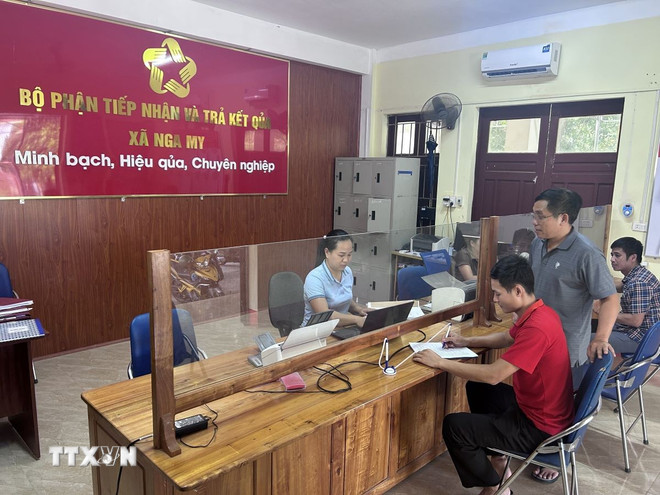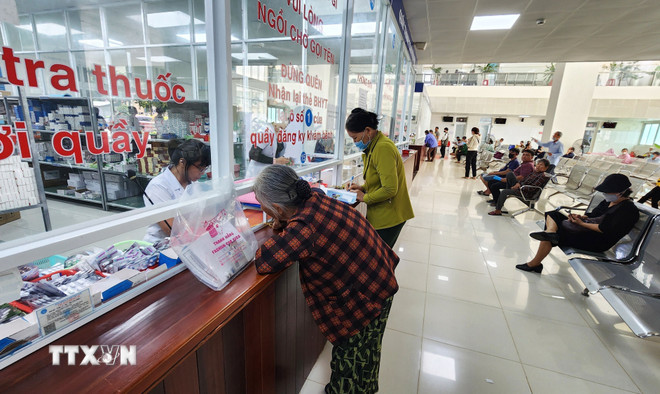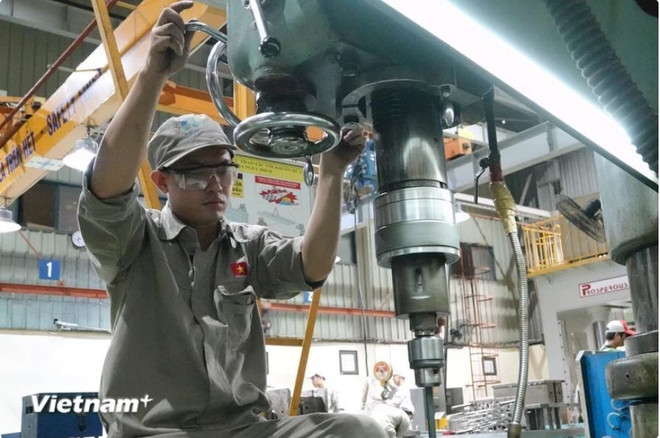The Central Steering Committee on summarizing Resolution No. 18-NQ/TW requests the People's Committees of provinces and centrally run cities to proactively develop plans to arrange public service units under their management according to each sector and field, ensuring compliance with the Steering Committee's orientation in Official Dispatch No. 59-CV/BCĐ and the guidance of the Ministries managing the sector and field, and send it to the Standing Committee of the Government Party Committee for consideration, decision and send it to the Ministry of Home Affairs for synthesis before September 25, 2025.
This is one of the main contents of Plan 130/KH-BCĐTKNQ18 on the arrangement of public service units, state-owned enterprises, and organizations within the state administrative system, which has just been signed and issued by Permanent Deputy Prime Minister Nguyen Hoa Binh - Deputy Head of the Central Steering Committee on summarizing Resolution No. 18-NQ/TW.
The plan clearly states that, implementing Document No. 59-CV/BCĐ dated September 12, 2025 of the Central Steering Committee on summarizing Resolution No. 18-NQ/TW on the arrangement of public service units, state-owned enterprises and focal points within agencies and organizations in the political system, the Steering Committee on summarizing the implementation of Resolution No. 18-NQ/TW of the Government requests ministries, ministerial-level agencies, government agencies, and People's Committees of provinces and centrally run cities (ministries, branches, and localities) to implement a number of key contents. Specifically:
For administrative organizations
At the Central level: Continue to review and streamline the organizational structure in ministries, ministerial-level agencies, and government agencies, especially department-level units and bureaus under ministries and branches, to ensure no overlap in functions and tasks.
Strictly implement the policy of not establishing departments in departments under ministries and branches; in special cases, for departments under ministries and branches that have recently merged or consolidated from 03 or more department-level focal points or have a large number of staff (from 45 staff or more), it is possible to consider establishing departments (implemented in accordance with regulations, each department has 15 or more people).
At the local level: Review and promptly issue regulations on the functions, tasks, and organizational structure of provincial and communal-level agencies, units, and organizations, especially those after mergers and acquisitions under the new model; propose and make reasonable adjustments if necessary to ensure no overlap or omission of functions and tasks; continue to research and propose plans to streamline the internal organizations of provincial-level departments, agencies, branches, agencies, and units.
For public service units
At the Central level:
Proposing to arrange and consolidate public service units according to the requirements of Resolution No. 19-NQ/TW dated October 25, 2017 of the 6th Central Conference of the 12th tenure, the Central Steering Committee on summarizing the implementation of Resolution No. 18-NQ/TW, the Government's Steering Committee on summarizing the implementation of Resolution No. 18-NQ/TW, Government regulations, and directions of the Prime Minister, including:

For Ministries and ministerial-level agencies: For public service units within the organizational structure, it is recommended to continue reviewing, arranging, and perfecting the internal organizational structure of these public service units, ensuring streamlining, improving the quality and efficiency of public service provision activities.
For public service units outside the organizational structure: Only retain units under ministries and branches serving political tasks and leading units associated with the functions and tasks of ministries and branches that fully meet the criteria and conditions for establishment according to regulations, in accordance with the planning of the network of public service units by industry and field; convert into joint stock companies when fully meeting the conditions prescribed by law. At the same time, review and arrange the internal organization of public service units, ensuring that they meet the criteria for establishing organizations according to regulations of the Government and the requirements for streamlining the organizational apparatus.
For academies, universities, colleges, vocational training institutions (colleges, intermediate schools): Build a number of schools and advanced training centers specializing in artificial intelligence; focus on arranging and reorganizing existing vocational training institutions to ensure they are streamlined, effective, and meet standards.
Strongly decentralize the management of vocational education institutions to local authorities; arrange and restructure higher education institutions; merge and dissolve substandard higher education institutions; eliminate intermediate levels, ensure streamlined, unified and effective administration; study the merger of research institutes with higher education institutions, and transfer a number of universities to local management.
For hospitals: Continue to arrange and transfer a number of hospitals under the Ministry of Health to provincial management. The Ministry of Health manages a number of specialized, high-tech, leading hospitals to carry out professional guidance tasks, train high-quality human resources, conduct scientific research, transfer technology, coordinate disease prevention and control, public health emergencies, natural disasters, catastrophes, and health security.
Strengthen and improve the capacity of the preventive health system in a modern direction, with sufficient capacity to monitor, provide early warning, promptly control epidemics and proactively organize and implement epidemic prevention and control activities. Strengthen the implementation of the Expanded Immunization Program in terms of both scope and vaccination subjects.
For public service units under offices and departments under ministries : Propose to rearrange public service units providing basic and essential public service services related to the industry and fields under management, ensuring streamlining, effective and efficient operations; other public service units must self-insure regular expenditures or more.
For the remaining public service units: Requirement to improve the effectiveness, efficiency of operations and level of financial autonomy. Develop a plan for financial autonomy and convert into a joint stock company when meeting all conditions as prescribed by law.
For Government agencies: Propose to reorganize and streamline public service units under management in the direction of streamlining, effective and efficient operations, ensuring the principle that one public service unit can provide many public service services of the same type in order to significantly reduce focal points, overcome overlaps, dispersion, and duplication of functions and tasks.
Locally
Public service units in the education sector: Strictly implement Resolution No. 71-NQ/TW dated August 22, 2025 of the Politburo on breakthroughs in education and training development. Basically maintain existing public high schools, middle schools, primary schools, inter-level schools, and kindergartens, propose arrangements and adjustments if necessary to conveniently serve the needs of people and students.
For mountainous provinces, highland areas, and ethnic minorities: Continue to review and arrange separate schools to focus on forming boarding and semi-boarding schools for ethnic students at commune or inter-commune centers.
Streamlining, reducing focal points, improving quality of operations: Merging vocational education centers and continuing education centers into vocational secondary schools equivalent to high school level under the Department of Education and Training to provide public services in inter-ward and commune areas; each province and city has a maximum of no more than 3 vocational schools to train skilled workers to serve socio-economic development and attract investment in the locality (not including schools that are self-sufficient in regular expenditure or higher).
Public service units in the health sector: Strictly implement Resolution No. 72-NQ/TW dated September 9, 2025 of the Politburo on a number of breakthrough solutions to strengthen the protection, care and improvement of people's health. Complete a modern preventive health system with sufficient capacity to monitor, provide early warning, promptly control epidemics and proactively organize and implement disease prevention activities.
Maintain existing provincial public hospitals; promote socialization where conditions permit. Each province and city has at least one specialized hospital; a geriatric hospital or a general hospital with a geriatric department.
Establish commune, ward and special zone health stations under the People's Committees at the commune level and medical examination points on the basis of the previous commune health stations to meet the needs of disease prevention, primary health care, and basic medical examination and treatment for the people in the area. Improve the quality and efficiency of grassroots health care. Focus on perfecting the functions, tasks and organizational structure of commune health stations according to the model of public service units, ensuring the provision of basic and essential services for disease prevention, primary health care, medical examination and treatment and social care services.

Transfer the former district-level medical centers and general hospitals to the Department of Health to organize care, examination and treatment according to inter-ward and commune areas.
Public service units in other fields (agriculture and environment, science and technology, project management, land fund development, site clearance...): Arrange and consolidate public service units according to the requirements of Resolution No. 19-NQ/TW, the Central Steering Committee on summarizing the implementation of Resolution No. 18-NQ/TW, the Government Steering Committee on summarizing the implementation of Resolution No. 18-NQ/TW, the Government's regulations, the Prime Minister's direction and the guidance of the Ministry managing the sector and field (especially the arrangement of public service units at the commune level when implementing the 2-level local government model); Review and reorganize public service units under management in a streamlined, effective and efficient manner, ensuring the principle that one public service unit can provide many public service services of the same type in order to significantly reduce the number of focal points, overcome overlaps, dispersion, and duplication of functions and tasks.
For public service units under specialized agencies under the People's Committees of provincial level (departments): It is recommended to continue researching, reviewing, arranging, and reorganizing public service units under departments. Each department (except the Department of Education and Training and the Department of Health) only maintains 1 public service unit to perform the function of serving state management, the remaining public service units must self-insure regular expenses or more.
For state-owned enterprises

Research and develop a number of large-scale domestic strategic digital technology enterprises to develop digital infrastructure, lead the direction of national digital transformation activities, and have international competitiveness and capacity.
Restructuring state-owned enterprises, equitization, and divestment of state capital according to the principle: State-owned enterprises only focus on key, essential, strategic areas; important areas and national defense and security; necessary areas that enterprises of other economic sectors do not invest in.
Submit the arrangement plan to the Ministry of Home Affairs before September 25, 2025
The Steering Committee requests the People's Committees of provinces and centrally run cities to proactively develop plans to arrange public service units under their management according to each sector and field, ensuring compliance with the Steering Committee's orientation in Official Dispatch No. 59-CV/BCĐ and the guidance of the Ministries managing the sector and field, and send them to the Standing Committee of the Government Party Committee for consideration, decision and send them to the Ministry of Home Affairs for synthesis before September 25, 2025.
Ministries, ministerial-level agencies, and government agencies shall proactively develop plans to reorganize public service units under their management authority, ensuring compliance with the direction of the Steering Committee in Official Dispatch No. 59-CV/BCĐ, send them to the Standing Committee of the Government Party Committee for consideration, decision, and send them to the Ministry of Home Affairs for synthesis before September 25, 2025./.
Source: https://www.vietnamplus.vn/sap-xep-don-vi-su-nghiep-cong-lap-dnnn-to-chuc-ben-trong-he-thong-hanh-chinh-nha-nuoc-post1063259.vnp



![[Photo] Da Nang: Hundreds of people join hands to clean up a vital tourist route after storm No. 13](https://vphoto.vietnam.vn/thumb/1200x675/vietnam/resource/IMAGE/2025/11/07/1762491638903_image-3-1353-jpg.webp)








































































































Comment (0)